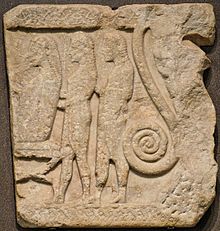
Back كابيري (آلهة العالم السفلي) Arabic Кабири Bulgarian Cabirs Catalan Kabeirové Czech Kabiren German Κάβειροι Greek Kabeiroj Esperanto Cabiros Spanish اسرار کابیریان Persian Cabires French

In Greek mythology, the Cabeiri or Cabiri /kəˈbaɪriː/[1] (Ancient Greek: Κάβειροι, Kábeiroi), also transliterated Kabeiri or Kabiri,[2] were a group of enigmatic chthonic deities. They were worshipped in a mystery cult closely associated with that of Hephaestus, centered in the north Aegean islands of Lemnos and possibly Samothrace—at the Samothrace temple complex—and at Thebes.[3] In their distant origins the Cabeiri and the Samothracian gods may include pre-Greek elements,[4] or other non-Greek elements, such as Thracian, Tyrrhenian, Pelasgian,[5] Phrygian or Hittite. The Lemnian cult was always local to Lemnos, but the Samothracian mystery cult spread rapidly throughout the Greek world during the Hellenistic period, eventually initiating Romans.
The ancient sources disagree about whether the deities of Samothrace were Cabeiri or not; and the accounts of the two cults differ in detail. But the two islands are close to each other, at the northern end of the Aegean, and the cults are at least similar, and neither fits easily into the Olympic pantheon: the Cabeiri were given a mythic genealogy as sons of Hephaestus and Cabeiro.[6] The accounts of the Samothracian gods, whose names were secret, differ in the number and sexes of the gods: usually between two and four, some of either sex. The number of Cabeiri also varies, with some accounts citing four (often a pair of males and a pair of females), and some even more, such as a tribe or whole race of Cabeiri, often presented as all male.[7]
The Cabeiri were also worshipped at other sites in the vicinity, including Seuthopolis in Thrace and various sites in Asia Minor. One of these is posited to be Thessalonica and possibly was the cult of mysteries of which Paul warns against in his letters to the church there.[8] According to Strabo, Cabeiri are most honored in Imbros and Lemnos but also in other cities too.[9]
- ^ "Cabiri". Merriam-Webster.com Dictionary.
- ^ Kabiri is the transliteration used in John Raffan's translation of Walter Burkert, Greek Religion (Harvard University Press, 1985).
- ^ *Peck, Harry Thurston (1898). "Cabeiria". Harpers Dictionary of Classical Antiquities. Tufts University: Perseus Project. Retrieved 2008-01-21.
- ^ Walter Burkert, Greek Religion, 1985, VI.1.3: '"the secret of the mysteries is rendered more enigmatic by the addition of a non-Greek, pre-Greek element, which is also hinted at in the Kaukon tradition of Andania" (a polis in Messenia).
- ^ "The inhabitants of Lemnos were called Tyrsenoi by the Greeks, and thus identified with the Etruscans, or alternatively with the Pelasgians." (Burkert 1985, eo. loc.).
- ^ Acusilaus, fr. 20; Pherecydes fr. 48; and Herodotus 3..37 are noted by Burkert.
- ^ Burkert, pp 281-84
- ^ Edson, Charles (1948). "Cults of Thessalonica (Macedonica III)". The Harvard Theological Review. 41 (3): 153–204. doi:10.1017/S0017816000019441. ISSN 0017-8160. JSTOR 1508109.
- ^ Strabo, Geography.
© MMXXIII Rich X Search. We shall prevail. All rights reserved. Rich X Search